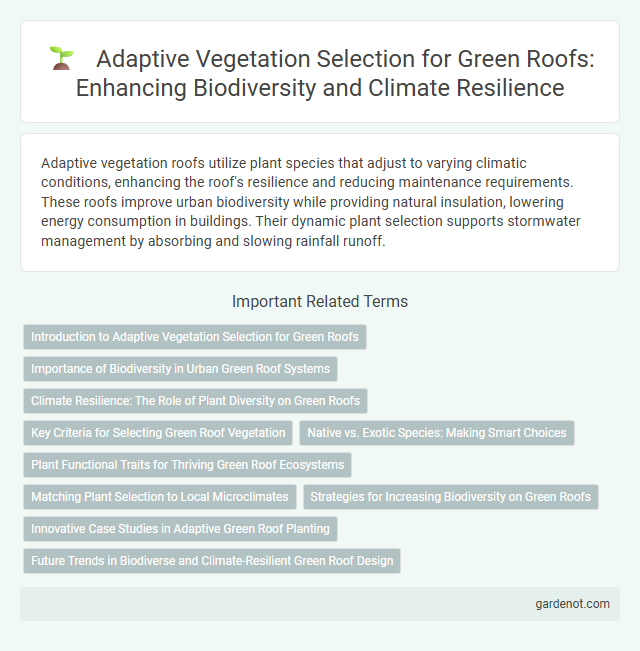Adaptive vegetation roofs utilize plant species that adjust to varying climatic conditions, enhancing the roof's resilience and reducing maintenance requirements. These roofs improve urban biodiversity while providing natural insulation, lowering energy consumption in buildings. Their dynamic plant selection supports stormwater management by absorbing and slowing rainfall runoff.
Introduction to Adaptive Vegetation Selection for Green Roofs
Adaptive vegetation selection for green roofs emphasizes choosing plant species that thrive under specific environmental conditions such as varying temperature, moisture, and sunlight exposure. These plants enhance roof resilience by improving thermal regulation, stormwater management, and biodiversity support. Selecting drought-tolerant, native, and stress-resistant species ensures sustainable growth and long-term performance of green roof systems.
Importance of Biodiversity in Urban Green Roof Systems
Adaptive vegetation roofs enhance urban biodiversity by supporting diverse plant species that improve ecosystem resilience and provide habitats for pollinators and birds. Incorporating native and drought-tolerant plants stabilizes soil, reduces urban heat island effects, and promotes natural pest control. Biodiversity-rich green roofs contribute to air quality improvement, stormwater management, and overall urban ecological balance.
Climate Resilience: The Role of Plant Diversity on Green Roofs
Adaptive vegetation roofs utilize diverse plant species to enhance climate resilience by improving temperature regulation and stormwater management on green roofs. Plant diversity increases the ecosystem's ability to withstand extreme weather events, reducing heat stress and enhancing water absorption. Incorporating various drought-tolerant and native species optimizes green roof performance, promoting biodiversity and ecological stability in urban environments.
Key Criteria for Selecting Green Roof Vegetation
Adaptive vegetation for green roofs must prioritize drought tolerance, root system depth, and resistance to local pests to ensure long-term sustainability. Selecting plant species with efficient photosynthesis rates and the ability to thrive in shallow substrates optimizes rooftop thermal performance and stormwater management. Emphasizing native or well-adapted species enhances biodiversity while reducing maintenance requirements for urban green roof ecosystems.
Native vs. Exotic Species: Making Smart Choices
Choosing native species for adaptive vegetation roofs enhances local biodiversity by supporting indigenous pollinators and wildlife, while exotic species may risk ecosystem imbalance and invasive behavior. Native plants typically require less maintenance, water, and fertilizer due to their adaptation to local climate and soil conditions, leading to more sustainable and resilient green roofs. Incorporating a diverse mix of native species optimizes the ecological benefits, improves stormwater management, and strengthens the overall durability of the green roof system.
Plant Functional Traits for Thriving Green Roof Ecosystems
Adaptive vegetation roofs utilize plant functional traits such as drought tolerance, root depth, and photosynthetic efficiency to enhance green roof resilience and biodiversity. Selecting species with traits suited for urban microclimates improves water retention, thermal regulation, and ecosystem services on green roofs. These trait-based approaches support thriving ecosystems by promoting plant survival, growth, and ecological interactions under variable rooftop conditions.
Matching Plant Selection to Local Microclimates
Adaptive vegetation roofs enhance urban biodiversity by selecting plant species that thrive in specific microclimates, optimizing growth and resilience. Matching plant selection to local microclimates accounts for factors like sunlight exposure, wind patterns, and moisture levels, ensuring sustainable green roof ecosystems. This strategic approach improves plant survival rates, reduces irrigation needs, and supports ecological balance on adaptive green roofs.
Strategies for Increasing Biodiversity on Green Roofs
Adaptive vegetation roofs employ diverse plant species tailored to local climates and microhabitats, enhancing ecosystem resilience and supporting native wildlife. Strategic layering of vegetation with varied root structures and seasonal growth cycles optimizes habitat complexity and resource availability. Incorporating pollinator-friendly plants and drought-tolerant natives fosters biodiversity while reducing maintenance and irrigation needs on green roofs.
Innovative Case Studies in Adaptive Green Roof Planting
Innovative case studies in adaptive green roof planting demonstrate the use of resilient plant species tailored to fluctuating urban microclimates, enhancing rooftop biodiversity and stormwater management. Research highlights native drought-tolerant sedums combined with modular planting systems that adjust to seasonal changes and varying sunlight exposure. These adaptive vegetation roofs improve thermal regulation, support pollinators, and extend the lifespan of roofing materials through dynamic plant community structures.
Future Trends in Biodiverse and Climate-Resilient Green Roof Design
Adaptive vegetation roofs integrate drought-tolerant and native plant species to enhance biodiversity while improving urban climate resilience. Incorporating smart irrigation systems and climate-responsive substrates optimizes water use and supports plant health amid fluctuating weather conditions. Future trends emphasize multifunctional green roofs that combine ecological benefits with energy efficiency and stormwater management.
Adaptive vegetation roof Infographic

 gardenot.com
gardenot.com